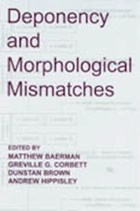Extended deponency: The right morphology in the wrong place
Project Overview
Project
Extended deponency: The right morphology in the wrong place
Project members:
Prof Greville G. Corbett
Dr Matthew Baerman
Dr Dunstan Brown
Period of award
January 2004 - June 2006
Funder:
Economic and Social Research Council (ESRC) - RES‑000‑23‑0375
Deponency is the term we have adopted to describe mismatches between morphology and morphosyntax. The prototypical example are the deponent verbs of Latin, which involve a mismatch between passive form and active meaning. That is, a normal Latin verb had active forms such as amō 'I love' and amāvī 'I have loved', which contrasted with the passive forms amor 'I am loved' and amātus sum 'I have been loved' (in this case, with a masculine subject). A deponent verb, on the other hand, looks like the passive but functions like the active, as in mīror 'I admire', mīrātus sum 'I have admired'.
In this project we construed deponency in an extended fashion, covering any mismatch between the apparent morphosyntactic value of a morphological form and its actual value in a given syntactic context.
A more detailed definition and an overview of the typological issues can be found here, and an annotated bibliography of works dealing with the theoretical implications of deponency can be found here.
Two databases resulted from this project. The cross-linguistic database looks at the presence of morphological mismatches in a controlled sample of genetically and geographically diverse languages (based on the 100-language sample from the World Atlas of Language Structures). The typological database records the logical space of deponency: what features may be affected, and what are the characteristics of the resulting paradigm? Every logical combination of parameters is represented by one exemplar (or where none has been found, this is noted too). The typological database is supplemented by a set of formal analyses of examples which hold particular interest for morphological theory.



